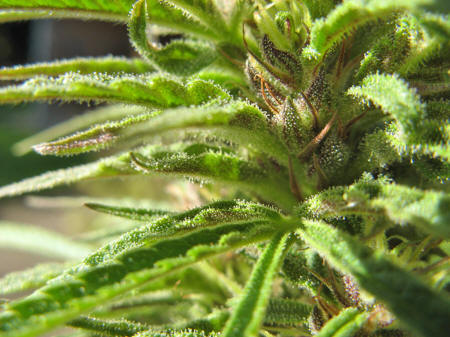|

by Anna Hunt
December 20, 2013
from
WakingTimes Website
Spanish version
|
Anna
Hunt is a staff writer
and an entrepreneur with over a decade of experience in
research
and editorial
writing.
She and her husband
run a preparedness e-store outlet at
www.offgridoutpost.com,
offering GMO-free
storable food and emergency kits. |

The Cannabis plant contains over 60
cannabinoids, which are carbon-containing terpenophenolic compounds
concentrated in the viscous resin of the glandular trichomes on the
cannabis plant bud.
There are psychoactive cannabinoids,
such as Delta-9-Tetrahydrocannabinol (THC), while others, such as
cannabidiol (CBD), have no psychoactive effects while offering
profound healing properties.
The human body responds to the cannabis
plant because its also has its own natural cannabinoids - called
endocannabinoids - which help establish and maintain human health.
The endogenous cannabinoid system,
named after the plant that led to its discovery, is perhaps the
most important physiologic system involved in establishing and
maintaining human health.
Endocannabinoids and their receptors
are found throughout the body: in the brain, organs, connective
tissues, glands, and immune cells. In each tissue, the
cannabinoid system performs different tasks, but the goal is
always the same: homeostasis, the maintenance of a stable
internal environment despite fluctuations in the external
environment.
Endocannabinoids and cannabinoids
are also found at the intersection of the body’s various
systems, allowing communication and coordination between
different cell types.
At the site of an injury, for
example, cannabinoids can be found decreasing the release of
activators and sensitizers from the injured tissue, stabilizing
the nerve cell to prevent excessive firing, and calming nearby
immune cells to prevent release of pro-inflammatory substances.
Three different mechanisms of action
on three different cell types for a single purpose: minimize the
pain and damage caused by the injury.
(source)
After the discovery of the body’s
natural cannabinoids, researchers and scientists have started
putting more time into exploring the affect that cannabinoids from
the cannabis plant have on the treatment of human ailments.
The following are 6 best-known
cannabinoids and how they are believed to affect the human body:
Delta-9-Tetrahydrocannabinol - THC
THC is the most well-known
cannabinoid and the main psychoactive constituent of cannabis.
THC has been used in the
treatments of chemotherapy-associated
nausea and vomiting. It is also used to stimulate the appetite
and increase food intake in AIDS and cancer patients.
THC has also been tested on
brain cancer cells and has been found to inhibit the growth of
brain tumors.
Furthermore,
THC has shown pain-reducing,
anti-tremor and anti-inflammatory properties.
Cannabidiol - CBD
CBDs hold the most promise for the
use of cannabis in the treatment of serious medical conditions.
CBDs
have been tested in the
treatment of cancer cells and are found to significantly inhibit
cancer cell growth. They also assist in the uptake of other
cancer drugs, increasing their effectiveness.
Other
research has also identified
CBD to have anti-inflammatory and pain reducing properties, and
others believe CBD has anti-convulsant,
anti-psychotic and neuro-protective properties. CBDs are also
known to alleviate some of the psychoactive effects of THC.
Cannabinol - CBN
CBN is a mildy-psychoactive
cannabinoid known as the sleep-inducing part of the cannabis
plant.
It increases the drowsy and
dizzy effects of THC.
High-CBN strains are being used as
sedatives and sleep-aids for those suffering from insomnia. Some
studies have been exploring the
potential use of CBNs in the treatment of osteoporosis.
Cannabichromene - CBC
CBCs are being evaluated for their
anti-inflammatory, anti-bacterial and anti-fungal properties.
Research has shown that CBC’s
anti-inflammatory activity is superior to those of
anti-inflammatory drugs. CBCs
have also been identified to
have a significant anti-depressant effect, contributing to the
overall mood-elevating properties of cannabis.
Finally, CBCs
may also increase the viability
of developing brain cells, a process called neurogenesis. Lack
of growth in the hippocampus part of the brain during old age is
believed to contribute to disorders such as Alzheimer’s and
depression.
Cannabigerol - CBG
CBG has been somewhat understudied
but research has shown that CBGs have a profound effect on the
body’s cannabinoid receptors.
Thus they work with other
cannabinoids to provide overall synergy and balance. CBGs
have been found to have an
anti-nausea and anti-vomiting effect, as well as reduce pain and
ease inflammation.
CGBs are also
known to increase the fluid drainage
from the eye and reduce the amount of pressure when treating
glaucoma. Industrial
hemp strains have been found to have the highest levels of
CBG when compared to other cannabis sativa strains.
Tetrahydrocannabivarin - THCV
THCV can be most commonly found in
the cannabis varieties indigenous to central Africa.
THCV
is being researched as a
treatment for metabolic disorders such as diabetes and obesity.
Research has shown that THCV
helps produce fat loss and results in an increased sensitivity
response to insulin.
Mounting research continues to establish
a strong case for the miraculous healing capabilities of
cannabinoids.
Our support of cannabis
plant cultivation and continued scientific research will lead to
more availability of various cannabis strains specifically designed
to have high doses of certain cannabinoids and thus serve as
safe medication for horrific ailments.
The use of medical marijuana and
cannabis-derived medicines in the treatment of diseases such as
cancer, epilepsy, chronic pain, diabetes, multiple sclerosis,
insomnia, depression, etc., will continue to grow.
Cannabis may yet become one of the most
useful natural remedies to some of the most crippling diseases of
mankind.
Sources
|


